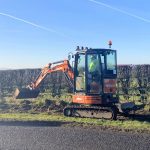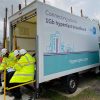VIDEO – Freedom Fibre CEO on Why Telegraph Poles are Still Needed

The CEO of alternative UK broadband network provider Freedom Fibre (FF), Neil McArthur, has published a new video where he attempts to explain why it’s sometimes necessary for Fibre-to-the-Premises (FTTP) builders and ISPs to erect a new telegraph pole, as opposed to conducting a more extensive underground dig.
At present FF, which is partly backed by UK ISP partner TalkTalk, is in the process of building a new 10Gbps capable FTTP broadband network across semi-rural parts of North England. The operator, which is supported by a capital investment of around £30m, has already covered roughly 10,000 premises, and they aim to reach 50,000 across the North West by summer 2022, before hitting 100,000 UK premises by the end of 2022.
Not unlike a fair few other AltNets, as well as major players like Openreach (BT), FF is also deploying some of its network using wooden telegraph poles. But as we’ve seen before, such poles have a tendency to divide public opinion when they’re erected (examples here, here and here) and, as a result, they remain one of the least loved pieces of modern broadband and phone infrastructure (not unlike mobile masts).
Advertisement
The CEO of Freedom Fibre, Neil McArthur, has now decided to publicly dip his feet into this debate by publishing a new video that offers a useful network operator’s perspective on why poles are still used. It’s worth a watch.
Freedom Fibre CEO on Telegraph Poles
As touched on in the video, poles are a fairly cost-effective solution for upgrading such networks, particularly in areas where the cost of going underground would be too high for a build to be viable. Poles are typically built using Permitted Development (PD) rights, which means they don’t have to go through the usual planning process and can pop up quite quickly, often without residents getting much of a say, which can sometimes add to the frustrations of those who oppose them.
On the flip side, poles remain quite a common sight across the UK and you can typically find plenty of people who would be more than happy to accept their deployment if it meant gaining access to a full fibre network. Likewise, there seems to be no shortage of studies claiming to show how the provision of faster broadband networks – via either pole or underground cables – tends to result in house values going up, rather than down.
Advertisement
We’d of course all prefer it if broadband and mobile infrastructure was totally invisible, but that’s not always possible.
Mark is a professional technology writer, IT consultant and computer engineer from Dorset (England), he also founded ISPreview in 1999 and enjoys analysing the latest telecoms and broadband developments. Find me on X (Twitter), Mastodon, Facebook, BlueSky, Threads.net and Linkedin.
« Freedom Fibre Extend UK FTTP Broadband Rollout into Shropshire
Openreach Chairman Tipped to Take on Same Role at Ofcom UK »























































It is explained that new poles are needed when the existing ducts cannot be used or it was just buried cables and new poles are cheaper than putting in new ducts. It does not explain why often companies are digging up roads and then in other cases they are not. Who decides what is done? Is it free for the networks to decide for themselves what they prefer what to do in each case. It may be cheaper to put in new poles but putting in ducts may be a better long term solution but the short term commercial imperative will be new poles.
“Who decides what is done? Is it free for the networks to decide for themselves what they prefer what to do in each case”
The operator decides, based on engineering surveys and how much they can afford to invest to reach X number of premises in any given area.
Are poles really such a short term solution? No inspection required for 12 years after install then inspection every decade.
Where there is ducting which can take new cables, telcos should be obliged to use them rather than install poles. Where the ducting is inadequate, then the residents or local council should either accept poles, or agree to pay for the additional costs of upgrading.
As these decisions will take time, local councils should plan this well before any telco starts to installing new infrastructure.
Council = the taxpayer
If the residents don’t want a pole then they should either pay the cost themselves or accept that they don’t get better broadband
They should NOT depend on other people to pay a big bill just because they think a pole looks ugly
No it should be done properly by the infrastructure company from the start. The UK has too much slap dash infrastructure as it is (water companies decreasing investment so having to dump raw sewage into rivers and seas comes to mind here). Cutting costs now will reduce the reliability of the product. And the fly by night investment firms will be long gone with all the money by then.
Oh dear, some points to note from this interview:
Is planning permission needed?
Well technically no (permitted development rights)
Will you be using it for 5G?
We won’t (presumably someone else might though?)
We all want fibre, but I’m not sure that poles going up according to some unaccountable telco is acceptable.
If we need to pay a higher cost each month to enjoy a more reliable service over the next 40 years then so be it.
Telegraph poles are used across the world to deliver utilities because they are cost effective. Using poles minimises disruption but of course the trade off is the physical impact.
I’m not aware of any telcos installing poles in areas they dont already exist, but could be wrong. Most companies now deploying are maximising the use of existing infrastructure through PIA, as it is common sense to do so.
That said, some (cusch as City Fibre) will be building their own core network for future use and as such trenching as well.
Councils do not own the infrastructure so would have no role to play in planning the works.
> I’m not aware of any telcos installing poles in areas they dont already exist, but could be wrong.
It’s not uncommon for Openreach themselves to install new poles for FTTP, when the existing copper is underground. Reasons include because the copper is direct-buried, or the ducts are in very bad shape.
Haha, look up Toob in Southampton.
I’m interested in Neil McArthur’s comment that an installing an 85m section of duct results in 250 tons of CO2 emissions. I’ve never seen any analysis of the CO2 emissions for duct or pole usage and would be very interested to see some. Can anyone point me at a source of some data please?
It was 250kg not tons
Install what you want without any requirement for planning considerations because its cheap.
Maybe we should just close all the council planning permission offices and just let developers and self builders throw up whatever they want too. Providers naturally will defend their choices with the ‘you should think yourself lucky you got FTTP’ but that’s just PR speak for we will do whatever the hell we want and don’t care what you think or feel so long as we maximise ROI.
These companies aren’t building fibre for any other reason than to make money. They don’t give two hoots about your street your opinions or your broadband.
The problem I have is when they complain the cable is direct berried or the ducts are blocked the reason they are like that is a is the being lazy in the past or not maintaining their ducts so its their fault they need poles in the first place so they have only their self to blame yet they try to make out its not their fault
Ducts aren’t blocked because of openreach laziness. Mostly they are blocked because they have been damaged. Often by altnets!
Ducts get blocked for a variety of reasons. They get damaged due to ground movement or external forces. Vehicles on footpaths cause untold damage to underground services as well as the visible ground. A duct blockage can be cleared (usually).
Inevitably many will just get full due to existing cables and the explosion of PIA use. Its where existing ducts are full or don’t exist that poles are user.
in many case new poles are metl rather than wood. Putting new ductin in is very expensive paryicularly in urban areas. There is no telling in the ground as it can be poorly documented. They will usually use the existing poles inm rare cicumstances they might need to erect a new pole
Openreach only install wooden poles now. Metal poles will likely be replaced over time
Poles are cheap up front. Perhaps if operators of networks had huge fines when they leave customers without a connection for extended periods of time as happened to the residents of Y Nant in Wales after Storm Arwen, just a couple of stories later they might not be so keen on doing it on the cheap.
As for claiming it is not cost effective, the standing charge on gas is minimal and it’s *ALL* underground. New poles in areas that don’t have poles should be banned. The default should be for all infrastructure to be underground unless there are exceptional circumstances for it not to be.
Gas network is underground but far less coverage than the openreach network.
https://www.nongasmap.org.uk/
But I agree underground areas should be kept underground. It’s the wild west out there and slap dash fast low quality builds are where we are at.
That’s because the gas network isn’t installed to expensive to serve locations. People in rural areas don’t get to have service. You’ve used a terrible example. See also: sewers.
I don’t mind wooden poles.
I do mind that I now have cheap ugly tarmac pavements in my road instead of paving slabs, as tarmac is deemed an acceptable “making good” after slabs are dug up to do underground work.
I do mind that houses around me are festooned with satellite dishes.
But wooden poles I do not mind.
That should be just an interim reinstatement. A permanent one should replace the slabs.
Presume they couldn’t lift them and then put them back.
CRALEY Deploy fibre using the premises waterpipes. no need for trenching in many cases its predictable, repeatable and certainly manageable.
FTTP home-drop kits are available from CRALEY
Work smarter not harder
CRALEY.com
I am not happy with the telegraph pole outside of my house, I purchased the house four years ago and was informed by the agent that this would be removed quite soon as there were only five other properties connected to it and under ground cables were to be used,I have tried to sell my house on a number of occasions and dew to the pole they all back out of the sale,when is this pole likely to be moved.